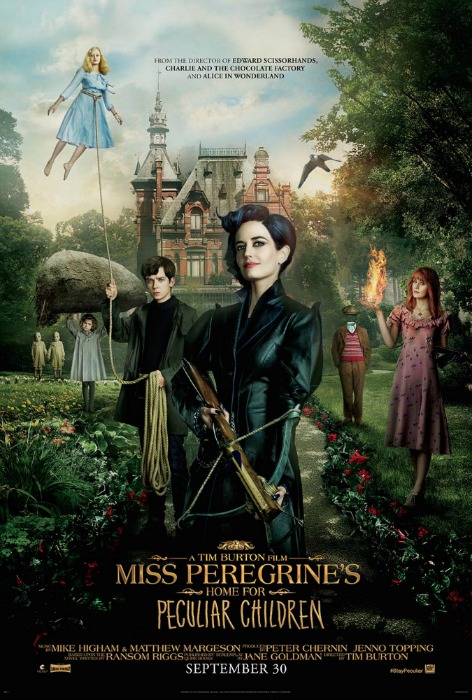Based on Ransom Riggs’ 2011 novel of the same name, Tim Burton’s latest effort, Miss Peregrine’s Home for Peculiar Children is a visual feast that tries too hard to make a statement while still being peculiarly colorblind.
Jacob Portman (Asa Butterfield) grew up listening to his grandfather’s stories about an orphanage full of peculiar children. After Grandpa is killed by a mysterious creature, Jake travels to Wales where he learns that the orphanage—and the children inside of it—haven’t changed in over seventy years. Miss Peregrine (Eva Green) keeps her talented charges in a time loop where it’s perpetually September 3rd, 1943, but, unfortunately, they’re now being hunted by Hollows, tentacled creatures who need to eat the eyeballs of peculiars in order to survive in human society.
If that synopsis is confusing you, I promise it makes more sense in the movie. Like the book, the movie starts off slow, building up Jake’s backstory before Miss Peregrine and Co make it onscreen approximately thirty minutes in. From there, we get to know each child’s peculiar talent, and watch in horror as the Hollows, led by a creepy Samuel L. Jackson as Mr. Barron, chase them across time and the UK—from the orphanage in Cairnholm, Wales to a final showdown at an amusement park in Blackpool, England.
For some bizarre reason, the peculiarities of some of the children were changed around during their transition from book into movie, most notably Emma Bloom (a dreamy-eyed Ella Purnell), whose fire power peculiarity is swapped for Olive’s (Lauren McCrostie) floating abilities. Some of the characters were also aged either up or down from the original book selves, resulting in two forced romance subplots, one of which is canon to the books (and is actually one of my least favorite ships ever because it’s so weird), while the other is unnecessary and doesn’t add anything to the story.
The highlight of the movie, apart from the adorable younger peculiars, is Eva Green’s Miss Peregrine. While she’s not as matronly as I originally pictured her, she rocks dark blue hair and a pipe-smoking habit while still exuding maternal instincts. Plus it’s pretty damn cool to see her transform into her namesake bird. Longtime Burton collaborator Colleen Atwood once again delivers sumptuous costumes that both stand out against the rich backdrop and blend in with the film’s overall aesthetic.
Unfortunately, for all the beautiful visuals, there’s a scene toward the end that cheapens the film. Suffice to say that as entertaining as reanimated skeletons can be (I’m thinking of these ones in particular), they ended up coming across as much more cheesy than effective and brought the film’s storytelling down a notch. In fact, the entire ending is rushed—they try to condense a three-book series into just over two hours, which means the last thirty minutes goes by at a breakneck speed.
Of course, the real controversy surrounded the film has been the lack of diversity in the cast—and Burton’s comments regarding his decision. Admittedly, the books are pretty white to begin with but if you can change the peculiarities of the characters without disrespecting the source material, it shouldn’t be too hard to change the color of their skin while you’re at it. Miss Peregrine’s home held a lot of children fleeing mainland Europe during the war, which is why they were mostly white, but if I’m already suspending my disbelief enough to accept a girl with a second mouth hidden under her curly hair, not to mention a concept as intangible as a time loop, why can’t the peculiars living in 1940s Wales have different colored skin? And there’s no need to have the one POC in the movie be a villain—especially a villain who didn’t exist in the book series to begin with.
The story is all about accepting those that are different from us—the ones with peculiar talents—and how they have their own (literal) demons to fight without being shunned from society, but Burton manages to make any viewer who is not “white” feel left out by refusing to include them in his films.
In the end: It’s pretty to look at and has an entertaining story, but knowing that the director is probably racist puts a bit of a damper on truly enjoying it.



